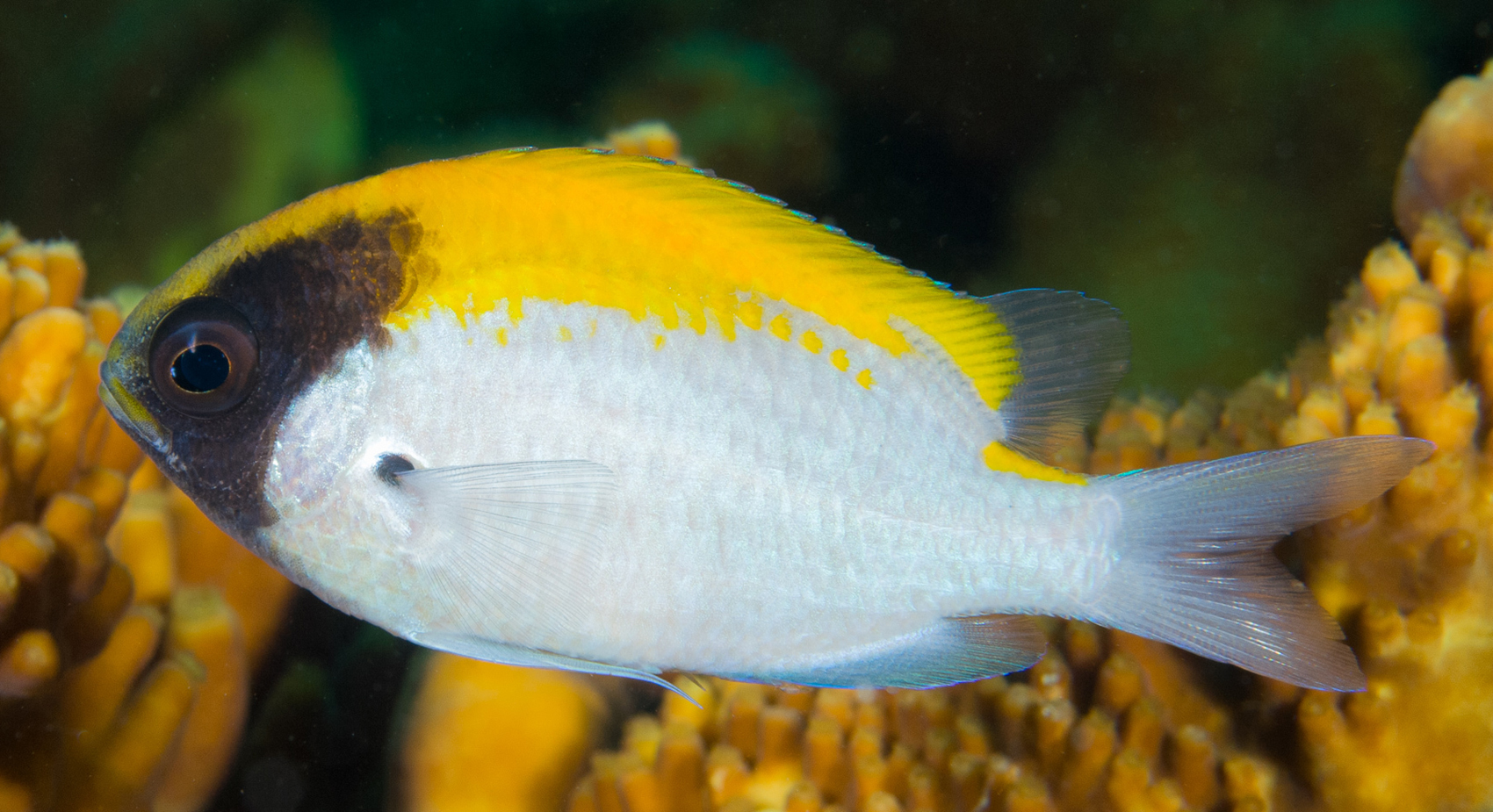- Classification
- ACTINOPTERYGII
- PERCIFORMES
- POMACENTRIDAE
- Chromis
- klunzingeri
Blackhead Puller, Chromis klunzingeri Whitley 1929
Other Names: Black-head Puller, Black-headed Chromis, Blackheaded Puller, Black-headed Puller

A Blackhead Puller, Chromis klunzingeri, at Rottnest Island, Western Australia, January 2007. Source: Wayne Osborn / iNaturalist.org. License: CC by Attribution-NonCommercial
Summary:
A whitish damselfish with bright yellow on the top of the head, back and dorsal fin, usually a broad black patch or bar on the head through the eye, and a large black spot in the axil of the pectoral fin. Some individuals lack the black bar.
Cite this page as:
Bray, D.J. 2025, Chromis klunzingeri in Fishes of Australia, accessed 10 Jul 2025, https://fishesofaustralia.net.au/Home/species/2317
Blackhead Puller, Chromis klunzingeri Whitley 1929
More Info
|
Distribution |
Endemic to south Western Australia from the Recherche Archipelago to the Houtman Abrolhos islands. Inhabits inshore and offshore coral and rocky reefs, most commonly along the south-west coast. |
|
Features |
Dorsal fin XIII, 13-14; Anal fin II, 13-14; Pectoral fin 18-19; Pelvic fin. I, 5; Caudal fin 15; Gill rakers (total) 27-29; Lateral-line scales 17-18. Body deep (approx. 52% SL) compressed, of moderate length. Head of moderate size (approx. 31% SL); eyes large (approx. 35% HL); mouth small, oblique; jaws with small conical teeth, outer row enlarged with irregular bands of villiform teeth behind. Scales ctenoid, large, covering body and head except small area around nostrils, small scales covering most membranes of vertical fins; lateral line interrupted, anterior segment following contour of back to below first few soft dorsal fin rays, posterior segment originating immediately below on midline of side, continuing to base of caudal fin. Dorsal fin continuous, with elongate base, first spine short, following three spines progressively longer, subsequent spines progressively shorter, segmented rays distinctly longer than adjacent spines; anal fin moderately small, similar and opposite posterior half of dorsal fin, first spine short, second more than twice the length of first; caudal fin forked, tips pointed, upper and lower edges of caudal base usually with two or three projecting spiniform procurrent rays. Pectoral and pelvic fins of moderate size, pointed; pelvics thoracic in position. |
|
Colour |
Sides of body below lateral line white, yellow above; broad black band on each side of head extending from chin, across eye to back of head totally covering preopercle, forehead yellow; small black spot on each pectoral fin base. |
|
Feeding |
May form large aggregations to feed on plankton in the water column. |
|
Etymology |
Named in honour of Carl Klunzinger, who who first recorded this species in 1879 (as Heliastes hypsilepis). |
|
Species Citation |
Chromis klunzingeri Whitley 1929, Memoirs of the Queensland Museum 9(3): 244. Type locality: King George Sound, Western Australia. |
|
Author |
Bray, D.J. 2025 |
|
Resources |
Blackhead Puller, Chromis klunzingeri Whitley 1929
References
Allen, G.R. 1991. Damselfishes of the World. Melle, Germany : Mergus Verlag 271 pp.
Allen, G. R. 2001. Family Pomacentridae in Carpenter, K.E. & Niem, T.H. (eds) The Living Marine Resources of the Western Central Pacific. FAO Species Identification Guide for Fisheries Purposes. Rome : FAO Vol. 6 pp. 3381-4218.
Allen, G.R. 2022. Chromis klunzingeri. The IUCN Red List of Threatened Species 2022: e.T188587A1898270. https://dx.doi.org/10.2305/IUCN.UK.2022-2.RLTS.T188587A1898270.en. Accessed on 28 April 2025.
Allen, G.R. & Gomon, M.F. 2008. Family Pomacentridae. pp. 634-638 in Gomon, M.F., Bray, D.J. & Kuiter, R.H. (eds) Fishes of Australia's Southern Coast. Sydney : Reed New Holland 928 pp.
Edgar, G.J. 2000. Australian Marine Life: the plants and animals of temperate waters. Sydney : Reed New Holland Revised Edn, 544 pp.
Harvey, E.S., Butler, J.J., McLean, D.L. & Shand, J. 2012. Contrasting habitat use of diurnal and nocturnal fish assemblages in temperate Western Australia. Journal of Experimental Marine Biology and Ecology 426-427: 78-86 https://doi.org/10.1016/j.jembe.2012.05.019
Hoschke, A., Whisson, G. & Moore, G.I. 2019. Complete list of fishes from Rottnest Island pp. 150-161 in Whisson, G. & Hoschke, A. (eds). The Rottnest Island fish book. 2nd ed. Perth : Aqua Research and Monitoring Services.
Hutchins, J.B. & Swainston, R. 1986. Sea Fishes of Southern Australia. Complete field guide for anglers and divers. Perth : Swainston Publishing 180 pp.
Hutchins, J.B. & Thompson, M. 1983. The Marine and Estuarine Fishes of South-western Australia. Perth : Western Australian Museum 103 pp. 345 figs.
Klunzinger, C.B. 1879. Die v. Müller'sche Sammlung australischer Fische. Anzeiger der Kaiserlichen Akademie der Wissenschaften, Wien, Mathematisch-Naturwissenschaftliche Classe 16(22): 254-261 (as Heliastes hypsilepis) See ref at BHL
Klunzinger, C.B. 1880. Die von Müller'sche Sammlung australischer Fische in Stuttgart. Sitzungsberichte der Kaiserlichen Akademie der Wissenschaften. Mathematisch-Naturwissenschaftliche Classe 80(1. Abth.) (nos 3-4): 325-430, Pls. 1-9 (as Heliastes hypsilepis) See ref at BHL
Kuiter, R.H. 1994. Family Pomacentridae. pp. 668-675, figs 586-591 in Gomon, M.F., Glover, C.J.M. & Kuiter, R.H. (eds) The Fishes of Australia's South Coast. Adelaide : State Printer 992 pp. 810 figs.
Kuiter, R.H. 1996. Guide to Sea Fishes of Australia. A comprehensive reference for divers and fishermen. Sydney, NSW, Australia : New Holland Publishers xvii, 434 pp.
Myers, E.M., Harvey, E.S., Saunders, B.J. & Travers, M.J. 2016. Fine‐scale patterns in the day, night and crepuscular composition of a temperate reef fish assemblage. Marine Ecology 37(3): 668-678. https://doi.org/10.1111/maec.12336
Whitley, G.P. 1929. Some fishes of the order Amphiprioniformes. Memoirs of the Queensland Museum 9(3): 207-246 figs 1-4 pls 27-28 See ref at BHL





